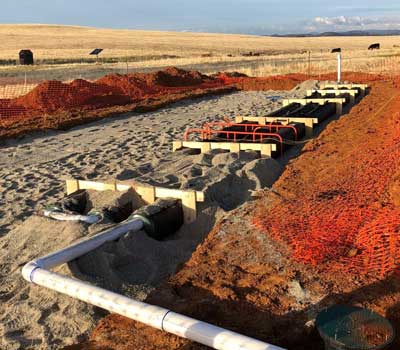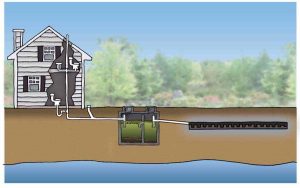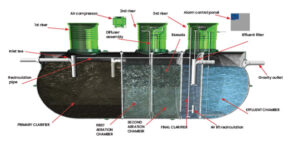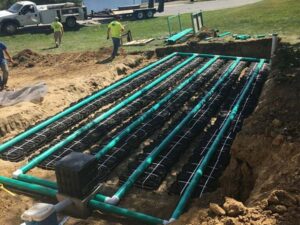How Does a Septic System Work
If you're like most homeowners, you probably don't think about your septic system until there's a problem. That's not necessarily a bad thing since septic systems are designed to be mostly self-sufficient. But if you're curious about how your septic system works—or want to know what to do if it stops working properly—keep reading. In this article, we'll take a look at the two main components of a conventional septic system and explain how they work together to keep your home sewage-free.
A conventional septic system consists of two main components—the septic tank and the leach field. The septic system is completely passive and can filter waste naturally. Gravity helps the waste separate and travel to its targeted destination while bacteria filters the water. The septic system takes all the sewage that leaves your home and makes it safe to enter the environment again. Not only does this sewage need somewhere to go to hide its horrible odor, the harmful bacteria and chemicals have to be filtered out before it gets to other sources of water. These pollutants can affect the environment and wildlife is the first to suffer from the effects of polluted water in lakes or streams.
Conventional septic systems don’t require any mechanical parts to work. The engineered septic system can be upgraded, however, to work more efficiently. Pumps can be added to improve the filtering process. Some landscapes are also not ideal for a conventional system. This might require you to include more steps in the process than you would get with a basic septic system design.
All the waste from the bathroom, kitchen drains, and washing machines leave the home in one drainage pipe. This pipe leads directly into the septic tank, the first part of the septic journey. For more information on how a septic tank works, check out our guide!
Common Types of Septic Systems

Septic Systems by Treatment Method
Septic systems can also be classified by how they treat wastewater: primary, secondary, or tertiary treatment. Primary treatment removes large objects from wastewater, such as food scraps or dirt. Secondary treatment uses bacteria to break down the waste and remove pollutants. Tertiary treatment is the most advanced, and can remove even smaller pollutants from the water.
Septic Systems by Installation Method
Septic systems can also be classified by how they are installed: buried or raised. Buried septic systems are installed below ground, while raised septic systems are installed above ground. Each type has its own advantages and disadvantages.
How does a raised septic system work? A raised septic system is installed above ground. It consists of a tank, which can be made of concrete, plastic, or fiberglass, and a leach field. The leach field is a bed of gravel that has been specially treated to filter sewage. Wastewater from the home flows into the tank, where it is treated by bacteria. The treated water then flows into the leach field, where it is filtered by the gravel and eventually returns to the environment.
How does a conventional septic system work?

What are the alternatives to a conventional septic system?
There are a few alternatives to a conventional septic system. One alternative is a septic pump. A septic pump pushes the wastewater from the tank to the drainfield. This is an effective way to move the wastewater, but it requires electricity. Another alternative is a graywater system. A graywater system recycles household wastewater for use in landscape irrigation. This is a great way to conserve water and reduce your impact on the environment.
How does a septic pump system work?
If you’re wondering how does a septic system with a pump work compared to one without, the answer might surprise you. Septic pump systems work by using a pump to move wastewater from the septic tank to the leach field. The pump is usually powered by electricity, but can also be powered by a gasoline or diesel engine. The pump moves the wastewater through a pipe called a force main to the leach field. The leach field is made up of a series of trenches or pipes that are filled with gravel and/or rocks. The wastewater flows through the gravel and rocks and is then absorbed into the soil.
How does a graywater system work?
Graywater systems recycle wastewater from baths, showers, sinks, and washing machines for use in landscape irrigation. The wastewater is collected in a tank where the solid materials are allowed to settle out. The wastewater then flows through a filter before it is discharged into the landscape. Graywater systems are a great way to conserve water and reduce your impact on the environment.
How Septic Systems Work

How does a aerobic septic system work?
The most common type of septic system is the aerobic septic system. This system uses an aerobic (oxygen-loving) bacteria to break down the wastewater. The wastewater is broken down in a tank, and then it is released into a leach field, where the bacteria breaks down the waste further and cleans the water before releasing it back into the environment.
How does a lagoon septic system work?
Lagoon septic systems are similar to aerobic septic systems, except that the wastewater is not broken down in a tank. Instead, it is released directly into a lagoon, where the bacteria breaks down the waste and cleans the water.
How does a septic mound system work?
Septic mound systems are similar to aerobic septic systems, except that the wastewater is not broken down in a tank. Instead, it is released directly into a mound of stones and soil, where the bacteria breaks down the waste and cleans the water.
How does a dry well septic system work?
Dry well septic systems are used in areas where there is no available soil to use for a leach field. In this system, the wastewater is released into a dry well, where it sits until it is absorbed by the surrounding soil.
How does a chamber septic system work?
Chamber septic systems are used when there is not enough space for a traditional leach field. In this system, the wastewater is released into individual chambers underground, where it sits until it is absorbed by the surrounding soil.
How does a septic finger system work?
Septic finger systems are used when there is not enough space for a traditional leach field. In this system, the wastewater is released into individual fingers underground, where it sits until it is absorbed by the surrounding soil.
How does a whitewater septic system work?
Whitewater septic systems are used when there is not enough space for a traditional leach field. In this system, the wastewater is released directly into a stream or river, where it mixes with the water and breaks down naturally.
How a Septic System Works in Residential, Commercial, and Municipal Settings

In the pretreatment stage, the wastewater is screened to remove large objects and then pumped into the primary treatment tank. In the primary treatment stage, the wastewater is treated with bacteria to break down solids. The wastewater then flows into the secondary treatment tank, where it is treated with more bacteria to break down organic matter. The treated wastewater is then discharged into the soil where it is filtered by the soil before entering groundwater or a water body.
How does a commercial septic system work?
If you’re wondering how septic system works for commercial applications, you’re not alone. A commercial septic system uses a septic tank to break down wastewater and a leaching field to distribute the wastewater evenly into the soil. The wastewater enters the tank where it is broken down by bacteria. The solids settle at the bottom of the tank while the liquids flow out into the leaching field. The leaching field is made up of a series of perforated pipes buried in gravel. The wastewater seeps through the gravel and into the soil where it is further broken down by bacteria. This process cleans and filters the water before it returns to the groundwater supply.
How does a residential septic system work?
We all know that sewer is more common in urban areas, but how does septic system work for homes that opt out of city sewer services? A septic system is a wastewater treatment system that is used in rural and suburban areas. It uses a tank to collect the wastewater from the home and a drainfield to disperse the wastewater. The tank breaks down the solid waste and the drainfield disperses the liquid waste. This functionality remains the same no matter where your home is located.
How does a community septic system work?
Everyone asks how do septic systems work for whole communities, and the answer is quite simple. Community septic systems work by collecting wastewater from homes in a neighborhood and treating it in a centralized location. The wastewater is treated using a variety of methods, including aerobic digestion, biofilters, and chlorine disinfection. The treated wastewater is then discharged into a local water body, such as a stream or lake. This helps to protect the environment by preventing the release of untreated wastewater into the environment.
Septic System Function FAQs
A two-tank septic system is more efficient than a single tank system. The first tank separates solid waste from the liquid waste. The liquid waste then flows to the second tank, which filters out any remaining particles and bacteria. This system is more efficient because it allows the first tank to become cleaner before sending the liquid waste to the second tank.
Because there are few recurring problems with Eljen septic systems, this is one of the most popular and reliable types of septic systems. Eljen septic system failures are rare, and homeowners with septic systems value reliability and low failure rates for peace of mind and budget predictability.
Even after you understand septic systems how they work for municipalities can still be challenging to picture. However, large-scale municipal septic systems can be constructed with similar considerations, specifications, and functionality to city sewer systems.
For example, how does a Presby septic system work for communities? A Presby septic system is a type of community septic system that uses a series of underground tanks and pipes to treat wastewater. The wastewater is broken down by bacteria in an aerobic process, which means that the bacteria need oxygen to survive. This type of septic system is ideal for communities with a large number of users, as it can handle a high volume of wastewater.
Learning to use your septic system as intended is crucial. Once you learn how to septic systems work much more efficiently. When you have a conventional septic system how it works is to remove and filter out organic waste. That means that inorganic waste, like plastics, will not break down and will cause back-ups. This is the most common cause of septic system failure, with the next being a lack of regular maintenance.
A septic system is a passive wastewater treatment system used in rural and suburban areas. The system consists of two main components: the septic tank and the leach field. The septic tank helps to separate and digest the waste while the leach field filters the water. Gravity helps to move the waste to its destination while bacteria breaks down the sewage. A septic system is an affordable and environmentally-friendly option for homeowners.
Not quite, but close enough. A properly installed and well-maintained septic system can last for many years--even decades--without any problems. However, over time the tank will fill up and will need to be emptied or replaced.
Septic systems use gravity and bacteria to filter and break down sewage. The sewage enters the septic tank, where it is separated from the water. The wastewater then flows through a series of perforated pipes in the leach field, where bacteria breaks down the waste. The clean water then drains back into the ground, while the solid waste settles in an absorption area of the leach field
Save 10% on All Septic Products
For All New Customers
"*" indicates required fields
